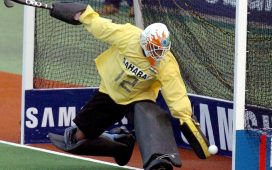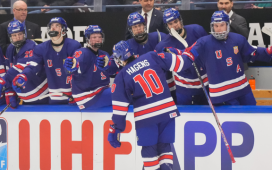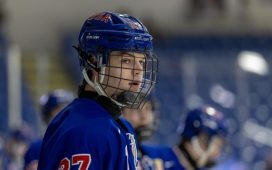BY DENIS GORMAN
If you lived in New York City in the mid-1950s, the debate was inescapable. Held in saloons and on playgrounds and in classrooms, at workplaces and the dinner table, and seemingly on every street corner, the arguments were impassioned and raucous and, for a time, unceasing. Who was better? Duke Snider, Willie Mays or Mickey Mantle?
More than six decades have passed since Snider, Mays and Mantle patrolled center field at the original Yankee Stadium, the Polo Grounds and Ebbets Field, respectively, and the Dodgers and Giants have long since left Brooklyn and Manhattan’s Washington Heights neighborhood for Los Angeles and San Francisco. In that time, coaches, athletes and teams have come through the New York City metropolitan region and captured championships or fans’ imagination – and, in some cases, both – for a spell. The list is long and encompasses the NCAA, NBA, NFL, MLB and the NHL, but at no point in the past 60-plus years were there three teams in the same sport at the same time that had a young franchise cornerstone.
Until now.
A hockey renaissance in the New York City metropolitan region is in its embryonic stage. If it is to gestate into a grand era, then 19-year-old rookies Jack Hughes and Kaapo Kakko and 22-year-old Mathew Barzal will be at its core. “They have that potential,” said Ken Daneyko, one of the cornerstones of the Devils’ three Stanley Cup-winning teams and now an analyst for MSG Network. “It’s great to see. It’ll be great for this area. Of course you want three studs. Barzal is already a stud. (Hughes and Kakko) have some catching up to do, but they’re young. It certainly would be great for the area.”
Not since the early 1950s, when Snider, Mays and Mantle were all under 25 years old, has there been this much hype and hope among New York-area fan bases in one league for a trio of young guns. Snider spent more than a decade in Brooklyn, regularly slamming 40 home runs and topping 100 RBIs with the Dodgers and bringing the New York City borough its only World Series title, in 1955. An all-time Yankee, Mantle was a three-time MVP, won the Triple Crown in 1956 and was a pillar on seven World Series-winning squads. Mays was simply one of the most talented players ever to play the game. He won rookie of the year and MVP honors while in New York and led the Giants to the 1954 World Series title, which included his iconic over-the-shoulder catch of a Vic Wertz drive in Game 1. All three became dynamic, game-changing forces in New York who altered the sports landscape in the area during the 1950s.
In Barzal, Hughes and Kakko, the NHL has phenoms in place to make hay during the 2020s in the most competitive sports market on the planet.
“The emergence of young stars for all three teams in the metropolitan area is certainly great for those clubs,” said NHL commissioner Gary Bettman. “And it is also emblematic of a league-wide trend. Players are becoming franchise cornerstones very early in their careers, on and off the ice, and that is exciting, especially for fans who will get to follow these young stars throughout their careers.”
In Hughes and Kakko, the Devils and Rangers each have a prodigy who is expected to morph into a franchise player. “Jack has been a prolific offensive player during his entire career,” said TSN director of scouting and former NHL GM Craig Button. “Jack has an unbelievably (creative) mind. He’s a big-time competitor. He can do things at a high rate of speed, moves with his feet, his hands and his head. And that’s what you have to be able to do in the NHL.”

The Devils drafted Hughes with the first overall pick last June. Just a few minutes later the Rangers took Kakko with the No. 2 pick, and they’re just as enamored with their teenager as the Devils are with theirs.
“He’s going to be a really, really good player,” said team president John Davidson. “He’s got a chance to be a great player. This kid’s got something. It’s going to be fun. It’s going to be fun to watch him develop.”
Meanwhile, in Barzal, the 2017-18 Calder Trophy winner, the Islanders have an elite offensive force who has already topped 80 points once and was on pace for another big year, even as coach Barry Trotz works on rounding out the youngster’s defensive game.
“With Mathew, I’m trying to make him the most complete player possible,” Trotz said. “Sometimes it’s hard, because he can have a great night where he can get three or four points, and the scoresheet is really good, but our goaltender had to be really good as well. There’s other nights where he’s dialed in on both sides of the puck and the chances are pretty one-sided. He’s a high-event guy. A lot of times he’s high-event for us.”
New York is a market where the hyper-passionate fan bases and critical media demand excellence (or at the very least competency) from the region’s professional sports franchises. To truly ignite the Barzal, Hughes and Kakko debate, all three NHL teams will eventually need to be in the mix for a title, or the hype surrounding their young stars will be over in a New York minute. The players haven’t had much in the way of head-to-head matchups yet, but frequent playoff encounters will play a pivotal role in fomenting the debate among fans.
Although Mantle, Mays and Snider weren’t personal rivals, their respective teams were archnemeses that faced each other regularly, often on baseball’s biggest stage. Between 1949 and 1957, at least one of the three New York teams participated in the World Series every year: the Yankees appeared in eight and won six, the Dodgers were featured in five and won one, and though the Giants lost in 1951, they won three years later. During that window, there were six all-New York World Series matchups, in which two of the three star centerfielders squared off.
In nearly 50 years in the NHL together, the Rangers and Islanders have met only eight times in the playoffs, with the last occurring in the 1994 Eastern Conference quarterfinal. The Rangers and Devils have faced off in six series, while the 1988 Patrick Division semifinal marked the lone Isles-Devils playoff showdown. Dating back to the Devils’ first season in New Jersey, in 1982-83, there have been only three times in which the Devils, Islanders and Rangers reached the playoffs in the same season (1989-90, 1993-94 and 2006-07).
If the three squads do rise up together, it won’t take long for the mutual enmity to heat up the discussion as to which club’s young phenom is better.
“That rivalry will always be there,” said NHL Network analyst and former Rangers captain Ryan Callahan. “Playoffs obviously make it more intensified, more under a microscope, but I remember going into the old (Nassau) Coliseum, and that place was rocking like it was Game 7 of the Stanley Cup final with Rangers fans and Islanders fans and chants going on. Same thing in (Madison Square) Garden every time we played the Islanders. New Jersey, same thing. So whether it’s playoffs or not, those three teams will always have that inner rivalry.”
Especially since they share the same backyard. Like so many quarrels about sports, emotion and the geographic and tribal prisms play a major role in making final determinations. The Snider, Mays, Mantle debate formed within the 16-mile crucible of the original Yankee Stadium, the Polo Grounds and Ebbets Field. The arteries for New York, New Jersey and Long Island are farther away, but it’s still just a 49-mile drive separating Barclays Center, Madison Square Garden, Prudential Center and the refurbished Nassau Coliseum.
For all the interconnectedness of the region, there are significant cultural differences among New Jersey, Long Island and New York City. NHL Network analyst Kevin Weekes would know. He is just one of 11 people who have played for all three New York City area teams.
“As far as New York, you’re part of the best city in the world, the world’s economic engine.” Weekes said. “It’s the heartbeat of the world in a lot of ways. Long Island, although it’s a suburb of New York City, it’s still very much New York, but you feel like you’re playing in a little bit more of a homey atmosphere, where people next door know you, where everybody kind of knows you. A little bit more closer-knit that way. Playing for the Devils, I felt it was kind of a scrappier experience. New Jersey, itself, felt like it was trying to prove something. Like, ‘Hey, we’re on this side of the Hudson. We’re trying to prove something in a different way.’ ”
Barring an unlikely trade, there’ll be plenty of time for the Barzal, Hughes and Kakko debate to swirl, assuming the trio all match their enormous potential. While Mantle remained in New York his entire career, Snider and Mays had to leave New York at the height of their powers after the Dodgers and Giants left for Los Angeles and San Francisco following the 1957 season. At least Devils, Islanders and Rangers fans won’t have to worry about franchise relocation. The Devils moved into the Prudential Center in Newark in October 2007. Madison Square Garden, which opened in 1968, finished a multi-year renovation in October 2013, and the Islanders are scheduled to open an arena on the grounds of Belmont Park racetrack in time for 2021-22.
After the Islanders’ lease at Nassau Coliseum expired at the end of the 2014-15 campaign, the team played the next three seasons at the not-designed-for-hockey Barclays Center. The site of the arena is where, during the early 1950s, Brooklyn Dodgers owner Walter O’Malley envisioned moving his team, but he was unable to reach an accord with New York City parks department commissioner Robert Moses, who was unyielding in his view that the Dodgers move to the Willets Point swath of land in Queens, where the New York Mets’ home parks, first Shea Stadium and now Citi Field, were built. In 2018-19, the Islanders, along with state and local political leaders and Barclays executives, worked out an arrangement in which the team would split home games between a refurbished Coliseum and the downtown Brooklyn venue until the Belmont Park arena opens.
With the New York area holding three of a kind in Barzal, Hughes and Kakko, the teams are playing with house money when it comes to promoting and selling their collective and individual products. But it is a supercharged market, and the sheer number of celebrities and newsmakers can create an atmosphere where attention spans are oftentimes fragmented.
Or worse. After all, it’s one thing to be able to go to a taping of The Late Show with Stephen Colbert, but it’s another thing to be a guest.
“We have to continue highlighting our star players and our great players across the league,” Weekes said. “They’re some of the best athletes in the world. And I’ll tell you right now, I don’t think that it’s fair for somebody as great as (New York Yankees right fielder) Aaron Judge is…or (Brooklyn Nets guard) Kyrie Irving, I don’t think that it’s fair for those guys to get the top billing, and then our hockey players, who are comparable athletes at the highest level in the world, for our guys and our sport to kind of get left in the shade a little bit.”
Still, for the area’s NHL fan bases it’s a net positive that Barzal, Hughes and Kakko are clustered together at this point in their careers. It means local hockey fans will have plenty of time to debate which franchise pillar has become the superior talent, much like their baseball-obsessed ancestors did so many years ago.
This is an edited version of a story that appeared in The Hockey News 2020 Rookie Issue. Want more in-depth features, analysis and opinions delivered right to your mailbox? Subscribe to The Hockey News magazine.








